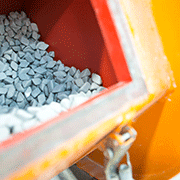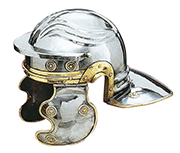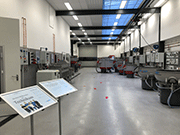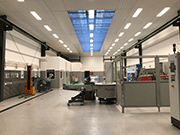E-Archive
Good Vibrations
in Vol. 19 - March Issue - Year 2018
The Evolution And The Building Stones For Modern Mass Finishing Processes





Roman helmet

Technikum (Vibratory part) of Spaleck Oberflächentechik

Technikum (Centrifugal part) of Spaleck Oberflächentechnik

Trial results are being measured by microscopic instruments, building up a 3D model of the part topography including edges and roughness
Based on industrial experience, we gain a certain amount of standard knowledge, which is broadly shared in the literature. This stored volume of information about mass finishing is supplemented by a large amount of practical application knowledge. This application knowledge is available to the user of mass finishing machines and processes, but especially, it exists in the heads of the manufacturers of surface finishing installations who constantly try to build better machines for better and more effective processes. But how do they create new knowledge, every day?
As the MFN editor, Paul Rawlinson has already mentioned in a very interesting former article, the basic principle of finishing metal surfaces by mixing a kind of abrasive media together with parts to be treated was already known in ancient times. Rawlinson described the example where the roman troops put parts of their metallic armor into sandbags during marching and transportation phases. The scouring of sand on the surface of the metal had a polishing effect on the personal armor, so that the next parade was optically impressive.
Even in prehistoric contexts, humans always strived to build perfect edges with stone tools. But burrs, which come from machining metal, would not appear until the Bronze Age or later periods of metal history. Obviously producing the desired edge is old history, though deburring is relatively new. Grinding wheels have been used on lathes in Egypt since 2100 B.C. The first iron weapons appeared in Mesopotamia in 1600 B.C., but metal jewelry and ornaments have been found dating back to the year 3000 B.C. and possibly as early as 4000 B.C. With the advent of jewelry and metal tools, deburring began to evolve. That first knowledge was not lost. The ancient Chinese and Egyptians used tumbling barrels with natural stones as added media to achieve smooth finishes on weapons and jewelry. The process was known as barrelling, rattling or tubbing. Stories were reported in 1948 that chains of armor in the medieval years of jousting (1100s and 1200s A.D.) required tumbling, as indicated by the statement, "Ye apprentice was required to place the parts in a cask along with small jagged stone fragments and tend to roll the cask about upon the ground until all the parts were smooth" (Beaver 1948a).
The first use of abrasive paper is documented in China in 1225. They coated paper with a natural gypsum, and worked crushed seashells into it (Pinkstone 1974). U.S. production of sandpaper began in 1828, although the first American lathe was patented in 1794. Burrs appeared regularly afterwards as parts came off these and other machines (Benes 1996). As a result, barrel tumbling was in common commercial use at the turn of the 20th century, as well as hand deburring being a standard process at the turn of the century. "Filing" was the common word for working on edges and surfaces until the early 1900’s, not deburring. "Finishing" was used occasionally, but "filing" was the word used at least from 1880 to 1916. The word "deburring" appeared in the 1940s.
After the Second World War, industrial mass finishing made huge steps forward. At the end of the 1940s the first preformed ceramic media were developed in Germany and at the start of the 1950s, the first U.S. synthetic random-shaped media were produced, followed by ceramic preforms in the mid-50s. In the second-half of the 1950s, tub type vibrators were developed in Germany and the U.S., followed by the use of plastic media. The 1960s produced another wave of inventions, liquid compounds, wet finishing, round vibrators with internal separation, round vibrators for steel media, flow-through systems and at the edge of the 1970s, the centrifugal finishing machines were born. During the 70s, vibratory finishing became the “standard” deburring process in large parts of the industry, and from the 1980s on, the different types of mass finishing machines well-known today were constantly developed further.
Today, the concatenation and integration of machines in fully automatic production environments is steadily on the rise. Smart machines with IT integration, database connection and remote process ability are starting to be a part of digitalized industry 4.0 environments. Work safety, documentation and risk assessments are becoming more and more important, that is nothing new, and have been mentioned in many written contributions before.
But are there really new inventions? Yes, they exist. Surface-finishing users and equipment producers are fiddling with new solutions. Existing hardware conceptions are being fine-tuned and upgraded with sensors and PLCs. A car in 2020 is totally different from a car in 1980. Together with the manufacturers of finishing equipment, they think up new processes. But as our ancestors discovered new knowledge by trial and error, this basic principle is a solid fundamental to learn new finishing processes still today. You can calculate input and output of parts. You can calculate the burden of welds and materials with software tools like Femap and other very sophisticated technology. You can make assumptions of material hardness and abrasive forces of media and calculate them considering the motor parameters of any machine, but you will never ever find out the real effect of a planned finishing process for a certain load of workpieces until you test it under real conditions.
The 20th century produced another German word, the Technikum. The Duden says that’s a technical school in Switzerland and Austria. In Germany, the term is also used for a kind of bench test where single appliances, machines or whole systems and auxiliary facilities are being tested for their suitability under industry operating conditions. And in fact, that is a good description of a Technikum facility in the surface finishing industry. It’s the place where finishing specialists can invent and test new equipment, where customers and solutions seekers can put their challenges on the table, and where interdisciplinary teams are discussing observations and drawing their conclusions for new surface finishing processes. The Technikum is a place where new loadable finishing knowledge is produced, not by accident, but by steady work.
Good Vibrations
by Mathieu Geuting
Spaleck Oberflächentechnik GmbH & Co. KG, Germany
Tel. +49.2871.9500 14
Fax +49.2871.9500 95
E-mail: m.geuting@spaleck.biz



























